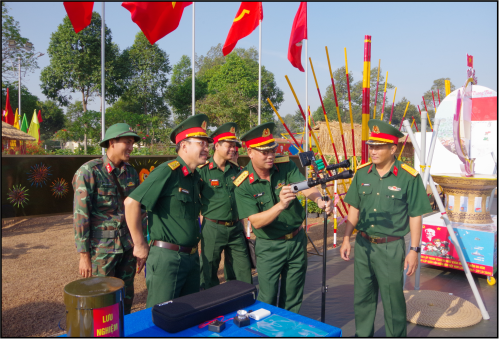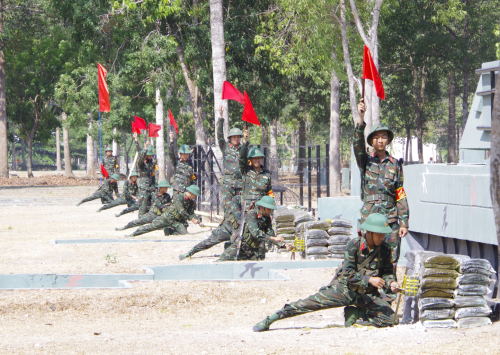Training is a central, routine task that directly contributes to improving the synergy, combat readiness capacity, and combat power of a military unit. As for full-strength main military units, training work becomes more important as it plays a decisive role in the performance of their political tasks in all situations. Being fully aware of that, over the years, the 9th Infantry Division (hereinafter referred to as the Division) under Army Corps 4 has devoted efforts to well implementing the task of combat training and always considered this task as a top criterion for assessing the competence of the party committee and command of each office and unit. In the implementation of this task, a part from advantages, the Division has been confronted with a lot of difficulties. More specifically, its affiliates are scattered in various areas; some cadres’ capability has yet to meet their task requirements; soldiers’ educational backgrounds are diverse while the requirements of training are increasingly higher. It is worth noting that under the Party line on building an “adept, compact, strong” Army, the Division will experience organisational adjustments, which will significantly impact on its cadres and soldiers, particularly young officers and cadres at detachment level.
 |
| Army Corps 4 inspects the Division’s preparatory work for training |
To deal with those above-mentioned problems, in addition to making the Division politically, ideologically, and organisationally strong, the Division’s Party Committee and Command have focused their leadership and direction on raising the quality of combat training to create synergy and maintain readiness for performing all tasks in any situation.
First of all, the Division has strengthened all-level party committees and commands’ leadership and direction over training work. This is a measure of importance to the training process, aimed at achieving a consensus within the whole unit. Grasping higher echelons’ resolutions and directives on training work, particularly the Central Military Commission’s Resolution 1659-NQ/QUTW dated 20 December 2022 on “raising the quality of training in period of 2023 – 2030 and beyond”, the Division’s Party Committee and Command have developed resolutions and action plans on training work as the basis for directing offices and units’ realisation of those resolutions and plans. Accordingly, the Division has directed its offices and units to enhance party and political work during training and particularly conduct propagation to raise cadres and soldiers’ awareness and responsibility. At the same time, due attention has been paid to renewing leadership, direction, and operation of training work, decentralising training work, delegate responsibilities to offices and commands, and improving the effectiveness of coordination between offices and units in directing, operating, guiding, and inspecting the implementation of training plans, process, and regulations. The Division has attached importance to promoting responsibility of all-level commanders, political commissars, junior political commissars, and party committee members for each piece of work and each training item. The Division has required all-level commanders to take responsibility for the results of training and live-fire combat exercises of their units. The results of training have been seen as a criterion for assessing the task performance of individuals and collectives, especially all-level key cadres and considering commendation for them. As a result, training work of the Division has been performed in a uniform, synchronous, scientific, effective way.
Additionally, the Division has focused on making necessary preparations for training, with significance attached to preparing manpower, means, and materials. On a yearly basis, prior to each training season, the Division’s Party Committee and Command have directed offices and units to hold refresher courses for their cadres and well conduct the work of preparing and approving lesson plans at all levels. Offices and units have reviewed and established their organisational structure relevant to the training characteristics of each speciality. Troops of infantry battalions have grouped according to their “military age range”; troops of specialised battalions have been organised into “compact companies”; troops of specialised companies have been organised into “compact platoons” in each conscription season to facilitate training management and organisation. While sending cadres to training courses held by the Army Corps, the Division has organised refresher courses for cadres at detachment level, particularly those from units tasked with the training of new soldiers or with live-fire exercises. Emphasis has been placed on overcoming weak points, introducing new points under higher echelons’ guidance, applying information technology, designing lesson plans, reporting the results of training at each level, and adopting methods of organising training work, operating practice, conducting examinations, and using model teams during practice. Besides, importance has been attached to holding refresher courses on training management and operation at all levels to completely eliminate overlapping training-related content and operation as well as one-way theoretical training. Thanks to the above-mentioned approach, all cadres of the Division have been able to undertake training work; 80% of battalion-level cadres and 95% of cadres at platoon and company levels have achieved merit or distinction in training work. That has been a deciding factor in the improved quality of training of the Division.
 |
| A training course for new soldiers |
To make a solid positive change in combat training, the Division has adhered to the guidelines and measures set by the Central Military Commission and the Division’s Party Committee, stepped up a reform in training programs, content, organisation, and methods, and made a breakthrough in raising the quality of training and live-fire exercises. The Division has directed its offices and units to strictly maintain regulations on training content, duration, and venue. In the training process, the Division has followed the motto of “basics, practicality, and solidity”, upheld synchronous, specialised training, taken infantry combat skills training as the fundamental, considered tactical training as the key, regarded practice and training on the existing and new weapons and equipment as the centre, and increased physical training, field marches, night-time operational training, and situations-based, projects-based training. At the same time, the Division has frequently renewed forms and methods of training relevant to each group of troops and each operational area. Learning from recent armed conflicts around the world and following higher echelons’ direction, the Division has actively designed and organised training courses on combating unmanned aerial vehicles (UAV) and shooting low-altitude aircraft to keep pace with modern warfare. Besides, in order to meet the requirements of combat set for a mobile main unit, the Division has concentrated on river-crossing and long-distance, heavily loaded march training to improve troops’ fitness and manoeuvrability on all types of terrain, particularly in riverine and urban areas, thus effectively responding to any situation.
In order to make the training of troops relevant to combat reality and correctly assess troops’ command, coordination, manoeuvrability, and capacity to deal with situations, the Division has directed its offices and units to well organise exercises, especially tactical and live-fire joint exercises at platoon, company, battalion, and regiment levels respectively. Moreover, the Division has directed its affiliates to well maintain contests and increase inspections of training results to ensure the practicality of training and fight against the “merit-driven disease”. Thanks to those effective measures, the Division has achieved a breakthrough in its training quality. In 2023 and the first half of 2024, all troops got pass, and over 75.8% of them achieved merit or distinction in training work; live-fire tactical exercises at platoon, company, battalion levels and live-fire combat exercises at squad level were held in an absolutely safe manner. It should be noted that the Division actively took part in a joint exercise at regimental level with one of its battalions practising fire, which was highly appreciated by the Ministry of National Defence.
A part from those above-mentioned measures, the Division has attached importance to carrying out support work for training and exercises. It has concentrated all resources on consolidating and sufficiently building training grounds for troops. Units of the Division have actively provided training tools, weapons, and equipment for training, particularly for manoeuvres and field marches. To settle difficulties in the supply of a large number of guns and artillery pieces which partly deteriorated, the Division has both effectively used budget allocated by higher echelons to consolidate training equipment and promoted its staff members’ responsibility for preservation and exploitation; it has enhanced the movement on promoting initiatives and renovating training equipment and gradually applied electronic lesson plans to training and practice. At the same time, the Division has closely cooperated with localities within Military Region 7 in ensuring safety for its marches. It has worked with the National Shooting Range Area 3 to provide support for its live-fire tactical and combat exercises, especially live-fire joint ones. The amount of weapons, equipment, ammunition, and explosives used for its yearly training and exercises is very enormous; therefore, the Division has strictly implemented regulations on maintaining and repairing weapons and equipment at all levels, intensified technical training and particularly safety training in using weapons, ammunition, and explosives. As a result, in many past years, the Division has recorded no incident in its training and exercises. Besides, the Division has always attached significance to carrying out logistics support work, providing sufficient rations for troops, and building good messes and quartermaster offices. The Division’s offices and units have well conducted the work of hygiene and epidemic prevention, thereby maintaining the rate of healthy troops at over 98% for combat training.
Those above-mentioned significant results in training have allowed the Division to keep raising its synergy and combat power, worthy of the tradition of a mobile main unit being twice given the title of “Hero of the People’s Armed Forces”, capable of undertaking and successfully fulfilling all assigned tasks.
Col. NGUYEN QUYET THANG
Deputy Commander and Chief of Staff of the Division